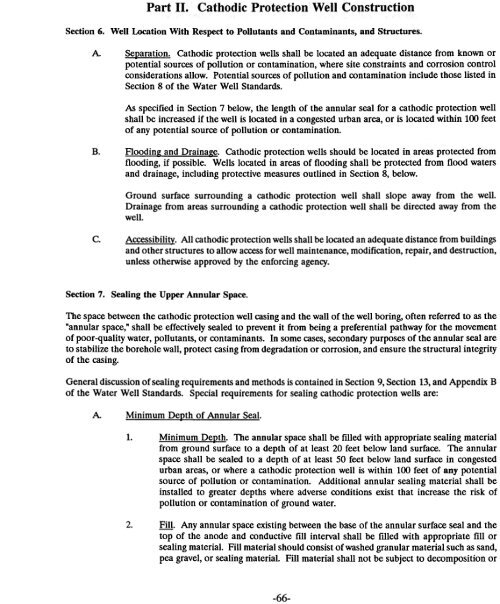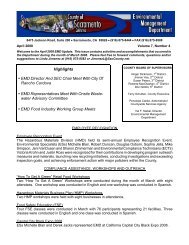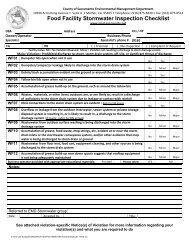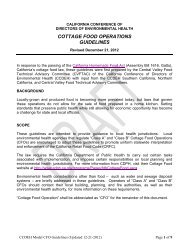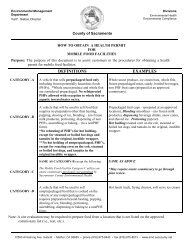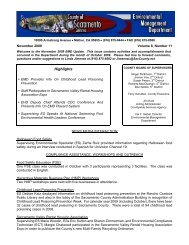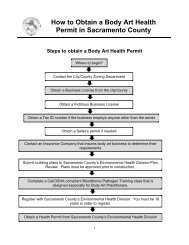California Water Well Standards, DWR Bulletin 74 ... - County of Glenn
California Water Well Standards, DWR Bulletin 74 ... - County of Glenn
California Water Well Standards, DWR Bulletin 74 ... - County of Glenn
- No tags were found...
Create successful ePaper yourself
Turn your PDF publications into a flip-book with our unique Google optimized e-Paper software.
B. ~ -66-Section 6. <strong>Well</strong> Location With Respecto Pollntants and Contaminants, and Structnres.ASe~aration. Cathodic protection wells shall be located an adequate distance from known orpotential sources <strong>of</strong> pollution or contamination, where site constraints and corrosion controlconsiderations allow. Potential sources <strong>of</strong> pollution and contamination include those listed inSection 8 <strong>of</strong> the <strong>Water</strong> <strong>Well</strong> <strong>Standards</strong>.As specified in Section 7 below, the length <strong>of</strong> the annular seal for a cathodic protection wellshall be increased if the well is located in a congested urban area, or is located within 100 feet<strong>of</strong> any potential source <strong>of</strong> pollution or contamination.Floodinl! and Drainage. Cathodic protection wells should be located in areas protected fromflooding, if possible. <strong>Well</strong>s located in areas <strong>of</strong> flooding shall be protected from flood watersand drainage, including protective measures outlined in Section 8, below.Ground surface surrounding a cathodic protection well shall slope away from the well.Drainage from areas surrounding a cathodic protection well shall be directed away from thewell.c. Accessibili!y. All cathodic protection wells shall be located an adequate distance from buildingsand other structures to allow access for well maintenance, modification, repair, and destruction,unless otherwise approved by the enforcing agency.Section 7. Sealing the Upper Annular Space.The space between the cathodic protection well casing and the wall <strong>of</strong> the well boring, <strong>of</strong>ten referred to as the"annular space," shall be effectively sealed to prevent it from being a preferential pathway for the movement<strong>of</strong> poor-quality water, pollutants, or contaminants. In some cases, secondary purposes <strong>of</strong> the annular seal areto stabilize the borehole wall, protect casing from degradation or corrosion, and ensure the structural integrity<strong>of</strong> the casing.General discussion <strong>of</strong> sealing requirements and methods is contained in Section 9, Section 13, and Appendix B<strong>of</strong> the <strong>Water</strong> <strong>Well</strong> <strong>Standards</strong>. Special requirements for sealing cathodic protection wells are:AMinimum De~th <strong>of</strong> Annular Seal.1. Minimum DeRth. The annular space shall be filled with appropriate sealing materialfrom ground surface to a depth <strong>of</strong> at least 20 feet below land surface. The annularspace shall be sealed to a depth <strong>of</strong> at least 50 feet below land surface in congestedurban areas, or where a cathodic protection well is within 100 feet <strong>of</strong> any potentialsource <strong>of</strong> pollution or contamination. Additional annular sealing material shall beinstalled to greater depths where adverse conditions exist that increase the risk <strong>of</strong>pollution or contamination <strong>of</strong> ground water.2. Bn. Any annular space existing between the base <strong>of</strong> the annular surface seal and thetop <strong>of</strong> the anode and conductive fill interval shall be filled with appropriate fill orsealing material. Fill material should consist <strong>of</strong> washed granular material such as sand,pea gravel, or sealing material. Fill material shall not be subject to decomposition or


